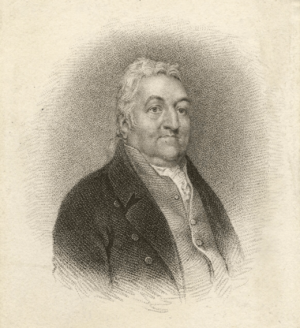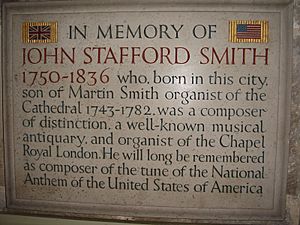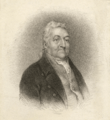John Stafford Smith facts for kids
Quick facts for kids
John Stafford Smith
|
|
|---|---|
 |
|
| Born |
Gloucester, England
|
| Baptized | 30 March 1750 |
| Died | 21 September 1836 (aged 86) London, England
|
| Occupation | Composer |
| Known for | Composed "The Anacreontic Song", later adopted as the tune of the national anthem of the United States |
John Stafford Smith (born March 30, 1750 – died September 21, 1836) was a British composer and church organist. He was also one of the first people to seriously collect old music. He gathered many old music papers, including works by famous composers like Johann Sebastian Bach.
Smith is most famous for writing the music for a song called "The Anacreontic Song". This song's tune was later used for "The Star-Spangled Banner". After the War of 1812, this became a popular American patriotic song. In 1931, it was officially chosen as the national anthem of the United States.
Contents
Early Life and Education
John Stafford Smith was born in Gloucester, England. He was baptized at Gloucester Cathedral on March 30, 1750. His father, Martin Smith, was the organist at Gloucester Cathedral for many years.
John went to the Gloucester cathedral school. There, he became a boy-singer in the choir. Later, he moved to London to become a choir boy at the Chapel Royal. He also studied music with a famous teacher named Dr. William Boyce.
Music Career
By the 1770s, John Stafford Smith was known as a talented composer and organist. He joined a special group called the Anacreontic Society. This society was for gentlemen who enjoyed music, poetry, and good company. Famous members included Samuel Johnson and Sir Joshua Reynolds.
Around this time, Smith wrote the music for the society's main song, "To Anacreon in Heaven" (also known as The Anacreontic Song). The words were written by Ralph Tomlinson, the president of the society. They were inspired by an ancient Greek poet named Anacreon, who wrote about love and happiness. This song became very popular in Britain and later in America.
Smith continued his successful career in music. In 1784, he became a Gentleman of the Chapel Royal. He later became the organist for the Chapel Royal in 1802. In 1805, he was made the Master of the Children, meaning he was in charge of the choir boys. He also worked at Westminster Abbey. Smith even met and worked with the famous composer Joseph Haydn when Haydn visited London.
Smith was also one of the first Englishmen to be a serious collector and expert of old music. He published a book called A Collection of English Song in 1779. This was one of the first times old English songs were put into a scholarly book. His personal library had many rare and old music papers. He collected works from as far back as the 12th century. In 1812, he published Musica Antiqua, which included old musical pieces and historical notes about them.
Death and Legacy

John Stafford Smith died in 1836 when he was 86 years old. He was buried at St Luke's Church in Chelsea, London. There is also a special memorial plaque for him in Gloucester Cathedral. Above his memorial, you can see the US and UK flags.
An interesting story says that Smith died because he choked on a grape seed. This is similar to a story about the ancient Greek poet Anacreon, who supposedly died the same way. The Anacreontic Society, for which Smith wrote his most famous song, was named after this poet.
The American National Anthem
In 1814, a lawyer named Francis Scott Key wrote a poem called "Defence of Fort M'Henry". This poem was later set to the tune of "Anacreon," the music composed by John Stafford Smith. This song became very important to Americans. In 1931, the US Congress officially made "The Star-Spangled Banner" the national anthem of the United States.
Images for kids


